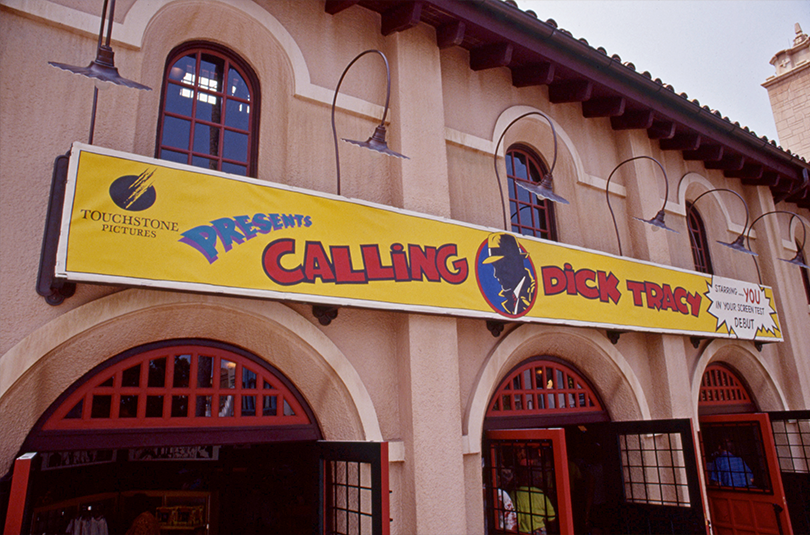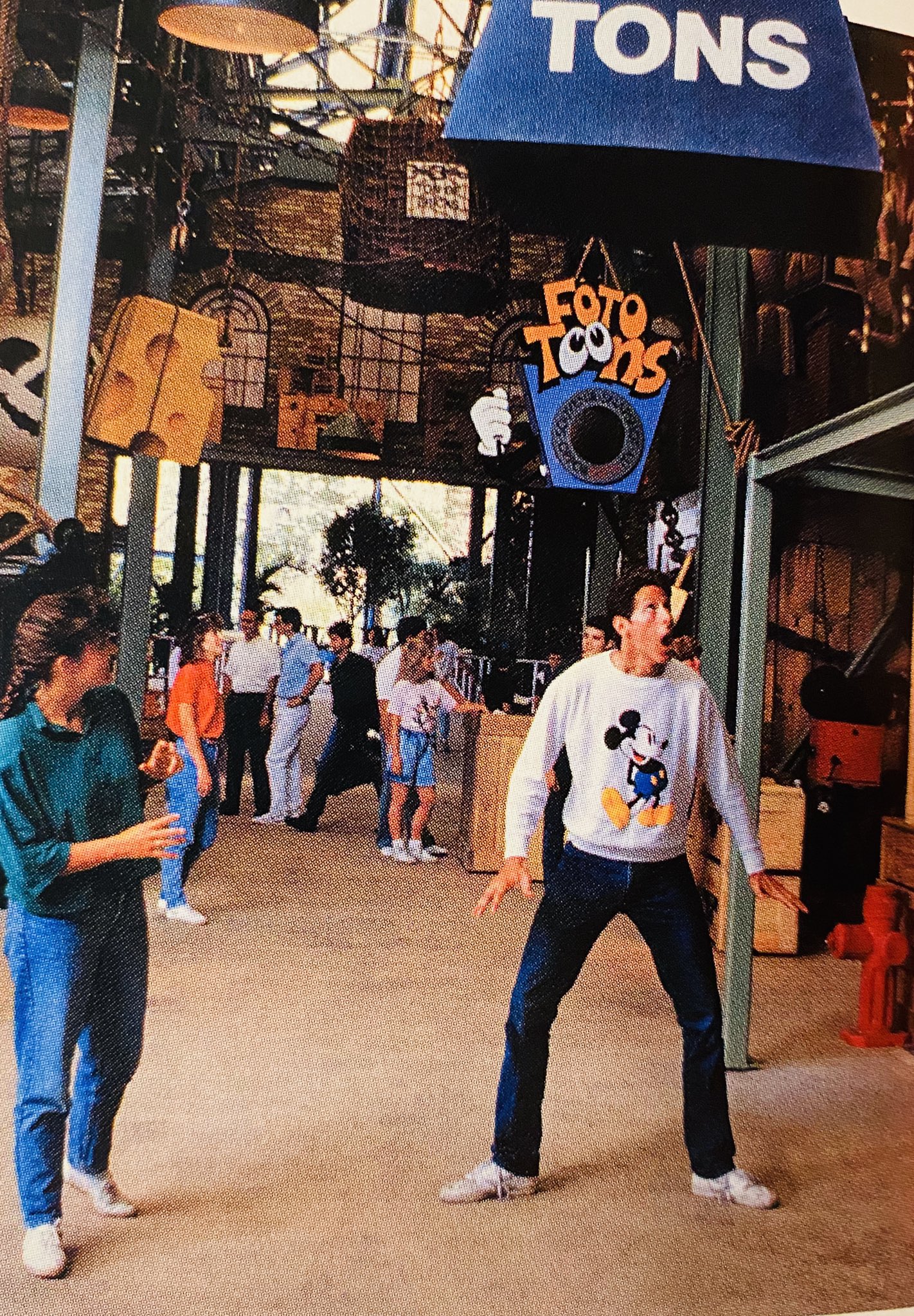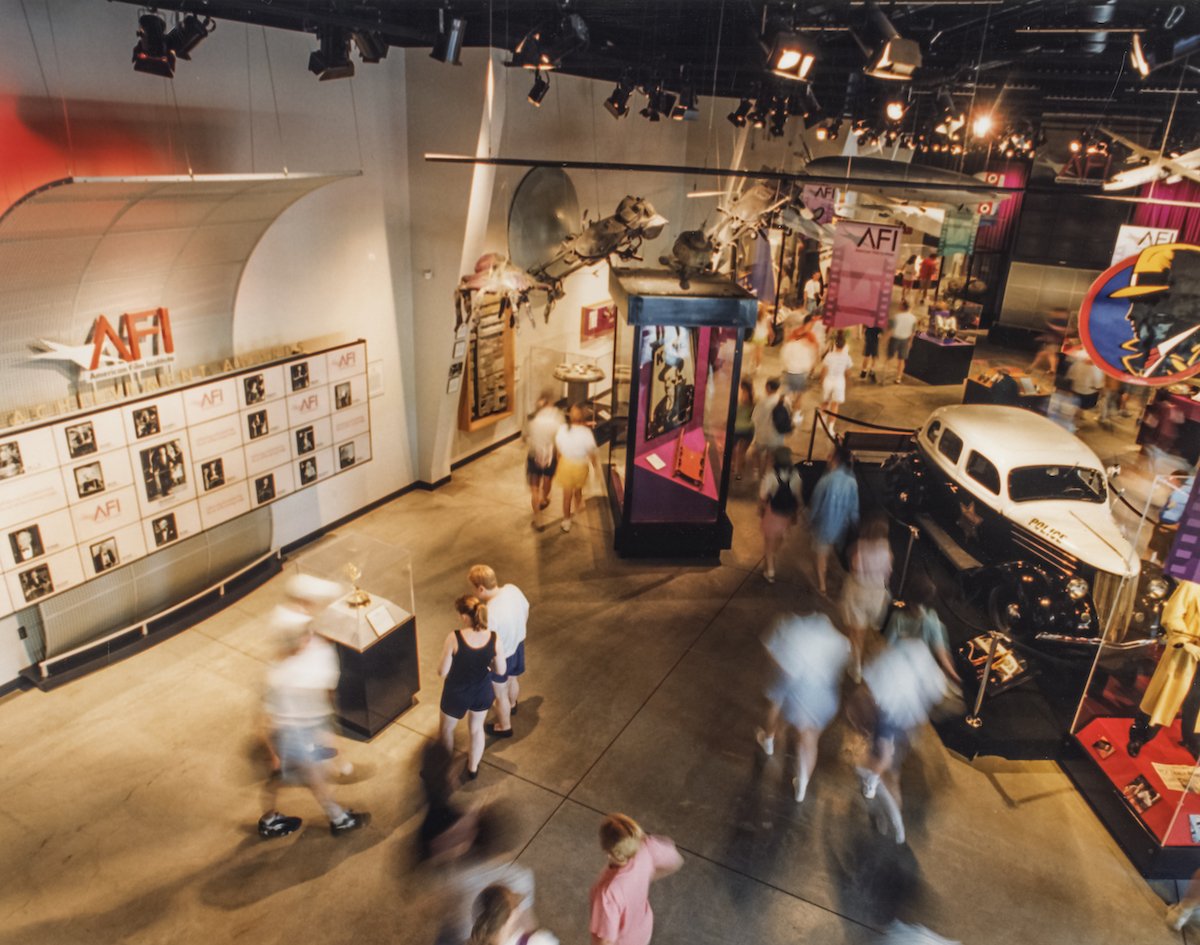Pacific Electric Pictures

The case could be made that technology has rendered it obsolete, but this is as much about the spirit of Pacific Electric Pictures as it is the experience.
As much it celebrated the off-camera art of cinema, Disney-MGM Studios was just as dedicated to minting stars and starlets. The magic of chroma key compositing wowed audiences across the park. Superstar Television used it to pit silly uncles against Tim “The Tool Man” Taylor in a hammer-and-nail race on Home Improvement. The walking component of the Tour, later split and christened Backstage Pass, inserted precocious volunteers into Honey, I Shrunk the Kids on the back of a runaway bee. The Indiana Jones Epic Stunt Spectacular trained a fresh batch of background actors hourly.
But if that still wasn’t enough auditioning for one day, guests could take home videotaped proof of their talent from Pacific Electric Pictures.
The building on the corner of Hollywood and Sunset has remained more or less unchanged since 1989. Imagineers based it on the Ivy Substation in Culver City, a power store for the real Pacific Electric Railway. A logo for it - Pacific Electric: World’s Wonderland Lines - adorns the far side just above the address - 1928, in honor of the Mickey Mouse’s debut year. In the early days, the trolley car doors along the side were much more obvious, as was its stealthy tie-in. Not only did the Pacific Electric factor into the plot of Who Framed Roger Rabbit, one of the prop trolleys built for the film could be seen on the backlot. Had Sunset Boulevard been built as intended, as a Roger Rabbit land, the Pacific Electric building would’ve subtly pointed the way.
All-in-all, classy digs for a notoriously, even proudly sleazy tenant.
Banners screamed Open Auditions Today! The Pacific Electric Pictures logo, an old-fashioned camera slashed through with white lightning, promised quality.
The owner, Louie Zirconium, did not. At the beginning of every $24.95 audition tape, he defined his personal creed as the exact opposite. It was easy to spot a Zirconium picture: “They ain’t gems - but they’re cheap!”
Wannabes were put into ill-fitting costumes and directed by in-character crew members to goof off before painted backdrops, each representing a different genre. Neither the writing nor the end product held a candle to Universal’s counterpart, Screen Test Home Video Adventure, but the experience and its personalized merchandise felt like a natural extension of Hollywood Boulevard.
Then it became a natural extension of Touchstone Pictures.
In May 1990, Pacific Electric Pictures turned into Calling Dick Tracy, in honor of Disney’s go-for-broke blockbuster. Instead of auditioning for Westerns or war movies, guests acted their hearts out for a chance to don the banana-yellow trenchcoat. A seedy, comic-book back alley replaced the alternating backdrops. Naturally, the retail space was rededicated to the onslaught of tie-in merchandise.
Though Dick Tracy did not make Disney go broke, it still fell well short of the studio’s Batman-sized expectations. Plans for a Tracy version of Sunset Boulevard, again making the Pacific Electric building a subliminal signpost, were scuttled. The casting call ended on January 12, 1991, just six months after the film premiered. A truncated version of the experience ran for two months following as Legends of Hollywood Screen Test, then closed for good in March.
The combination attraction-store reopened as an ordinary store, L.A. Property & Storage, not long after. It wasn’t a scrappy studio anymore, but prop warehouse one bad sneeze from total collapse. The name changed slightly over the years before settling on L.A. Prop & Cinema Storage in 1997, as it stayed until closing in June 2014. It’s now the park’s Starbucks location, the Trolley Car Café, and realigned with its outer theme as a disused substation.
This particular lost shop doesn’t inspire many fond memories simply because it didn’t last long enough to make them, souvenir tapes notwithstanding. The appeal of donning ten-gallon hats and riffing in front of a camera, on vacation no less, doesn’t hold the same novelty it once did. But it’s a lost grace note. Pacific Electric Pictures was a completely optional experience that lent texture to the Studios. It came at additional cost, but it wasn’t a triple-digit bill masquerading as an attraction, like certain workshops nearby.
More than anything else, it let guests be movie stars in a park now entirely focused on making guests star in movies. A small distinction, but one worth remembering fondly.
The Loony Bin

No Disney-MGM store is remembered more fondly than The Loony Bin, somewhat by force.
The original Backlot Studio Tour was so long that it had a break area in the middle so guests could eat and nap. As is policy at theme parks, the Backstage Plaza came complete with a gift shop. There was no way to miss this one, but at least it was special.
The Loony Bin was a love letter to Who Framed Roger Rabbit. The stuffed rabbits were just window dressing. The real star was the décor, done up like the ACME Warehouse from the end of the film.
A conveniently labeled “Ton of Bricks” dangled overhead on equally concerning magnets. Cargo nets strained to suspend concrete elephants and cartoon cheese wedges the size of compact cars. Leering jesters and smiling balloons hung wherever was left. The only prop that ever fell was a safe, right onto the head of an unlucky chalk outline. ACME-brand crates piled up across the rest of the floor, each marked with matter-of-fact purpose. The “Miscellaneous” box played miscellaneous sounds when opened, the “Animal Noises” box played animal noises, “Toots” tooted, etc. Alas, innocent bystanders were not allowed to get at the Singing Swords or Blow-Up Carrots.
Once the cacophony got old, shoppers could take their picture getting flattened under an errant steamroller or beside a Roger-shaped hole in the bricks. For a little extra, they could even cozy up to Jessica Rabbit in all her animated glory through the miracle of FotoToons technology.
In its earliest form, The Loony Bin was absolutely stuffed with gags to spring and sights to see. The Toon Patrol truck last seen at the Backlot Express was first parked here. Two red halves of a Pacific Electric trolley poked out from a far end of the scaffolding. Until New York Street was made walkable, this was as close as visitors could get to Judge Doom’s Dip Mobile outside of a moving tram.
It also, for however briefly, held a strange and unthinkable honor - The Loony Bin was the only place on Walt Disney World property that sold Warner Bros. merchandise. Bins full of plus Bugs Bunnies and Daffy Ducks waited beneath the watchful gaze of two glowing eyes in a crate marked “Tasmania.”
That particular licensing deal did not last long and neither did the Backlot Studio Tour in its original state. Once it was divided into driving and walking halves, the Backstage Plaza lost all meaning and The Loony Bin opened to ordinary foot traffic. In December 1990, a playground was added, the Honey, I Shrunk the Kids: Movie Set Adventure. The ACME crates knew little peace.
As the relevance of Roger Rabbit waned, so did the most obvious theming. FotoToons lost most of its luster with the advent of Photoshop. The Dip Mobile drove away. The steamroller wasn’t far behind. A standee of Jessica Rabbit left her husband or at least his exit silhouette. The props overhead thinned out, some pushed into corners and others dropped entirely. Even the name dulled with age. By the end, in 2016, it was just called the Studio Prop Shop.
But all was not lost. The concrete floor poured funny in the cracks formerly occupied by the steamroller and fallen safe. Behind two shelves, Roger’s literal mark survived on the wall. High on a crate-stacked catwalk, a Dick Tracy logo recovered from a New York Street marquee hid between boxes.
Now the former Backstage Plaza is part of Galaxy’s Edge, impossible to match without a GPS or photographic memory. Though it was a shadow of opening day, the Loony Bin remained a relatively pure artifact of the era until it closed. All that’s left of Roger Rabbit, once the poster boy for the park, is Eddie Valiant’s office near Echo Lake and two very large footprints outside the Chinese Theater.
AFI Showcase Shop

Disney’s Hollywood Studios has grown stunted by design. As a functioning production hub, it was built to change easily, even endlessly, but never take root. The first five years of park maps read like misprints laid out next to each other. One name might apply to three different locations in as many years, or one location might rack up three different names, two of which didn’t stick long enough for publication. It was a flex space built as such, first for filmmakers, then filmmakers and visitors, then only visitors.
The AFI Showcase was born of and victim to the change.
When the ambitious Muppet Studios plans were curtailed by Jim Henson’s death in 1990, the already-finished building for Swedish Chef’s Videocooking School was hastily repurposed as the Rocketeer Gallery. The space, conspicuously just across the plaza from Muppet*Vision 3D, displayed props and costumes from Disney’s 1991 would-be blockbuster. Like Tracy before it, The Rocketeer did not inspire audiences or a franchise, so the Gallery became the less-specific Studio Showcase.
Mine carts from Indiana Jones and the Temple of Doom teetered mid-chase past animatronic animal heads from Indiana Jones and the Last Crusade. Smashed Christopher Lloyd faces from Who Framed Roger Rabbit shared glass cases with troll heads from Ernest Scared Stupid. Most of the films that would belatedly define the early Disney-MGM years - The Rocketeer; Dick Tracy; Who Framed Roger Rabbit; the Honey, I... and Indiana Jones franchises - were well-represented in the Showcase.
In 1994, the Studio Backlot Tour was rerouted yet again to a brand-new exit building. The Studio Showcase, both title and contents, moved to fill it, carrying over an exhibit dedicated to The Nightmare Before Christmas. The old location briefly became the nondescript Studio Arcade before the release of Toy Story turned it into Pizza Planet in December 1995.
That same month, American Film Institute president Charlton Heston announced a partnership with Disney. The nonprofit organization would be sponsoring a remodeled Studio Showcase to rally funding for further film education and preservation.
The new and improved AFI Studio Showcase opened in February of 1996 with 7,000 square-feet of mostly-new cinema history. Rocketeer costumes, a jacuzzi-sized shoe from Honey, I Blew Up The Kid, and a suspended speederbike survived, but were hopelessly upstaged by the staff from The Ten Commandments and the sled from Citizen Kane. The emphasis shifted to the sum of the art instead of its recent bubble-gum hits.
When this Showcase launched, it celebrated each of its then-24 Life Achievement Award recipients, the latest being Clint Eastwood. Anyone thus moved by their work or AFI’s could purchase branded souvenirs in the Shop.
More than they ever had at the former Showcase, exhibits rotated. Creatures of Distinction turned the spotlight to the Muppets in time for Muppet Treasure Island. Driving the Story made room for every kind of picture car, including a stunt car from Gone in 60 Seconds and a full-scale rover from Mission to Mars, Disney’s first attempt at bringing attractions to the big screen.
The periodic refreshments slowed alongside production. In its later years, the Showcase settled into a standardized, museum-like presentation. The 2008 Villains collection told a familiar story a little too late. There was no way to get a picture of the original xenomorph suit from Alien without getting two of Susan Sarandon’s outfits from Enchanted in-frame. Leftovers from Disney’s almost-hits invaded once again, the contrast now sillier than ever.
The Showcase’s last exhibit would be, fittingly enough, AFI’s anniversary piece - 100 Years, 100 Movies. Only the Showcase Shop got the hint - unsold autographs and memorabilia from Sid Cahuenga’s arrived in 2013, when that Studios relic landmark closed.
The final collections of props, costumes, and behind-the-scenes was a lovely send-off. Wall-to-wall, glass-to-glass, it was all unbelievable, undisturbed history. An ax from The Shining. A lifeboat from Titanic. Michael Keaton’s batsuit. Christopher Reeves’s cape. A continuity script from Gone With The Wind. Storyboards from E.T. A bullwhip from Raiders of the Lost Ark, with live demonstrations still available across the park.
The American Film Institute Showcase and Shop closed on August 18, 2014. The pieces were sent back to their respective collectors. The Sid surplus, along with all AFI souvenirs and most of the film-centric merchandise, went with the store. There was nowhere left to move it.
Disney insisted this had nothing to do with any future closure of the Backlot Tour, but that only lasted another month. For the final Star Wars Weekends event in 2015, the former Showcase became Watto’s Grotto. The open floor plan allowed for an extensive, if strangely spread-out array of Episode VII - The Force Awakens merchandise. This temporary store lasted until April 2016, when the wrecking ball finally rose for the backlot.
Now Star Wars collectibles are available parkwide. With the closure of the Turner Classic Movies-sponsored Great Movie Ride, however, there is no attraction or store devoted purely to the art of film.
For 18 years, the AFI Showcase was both.

Add new comment